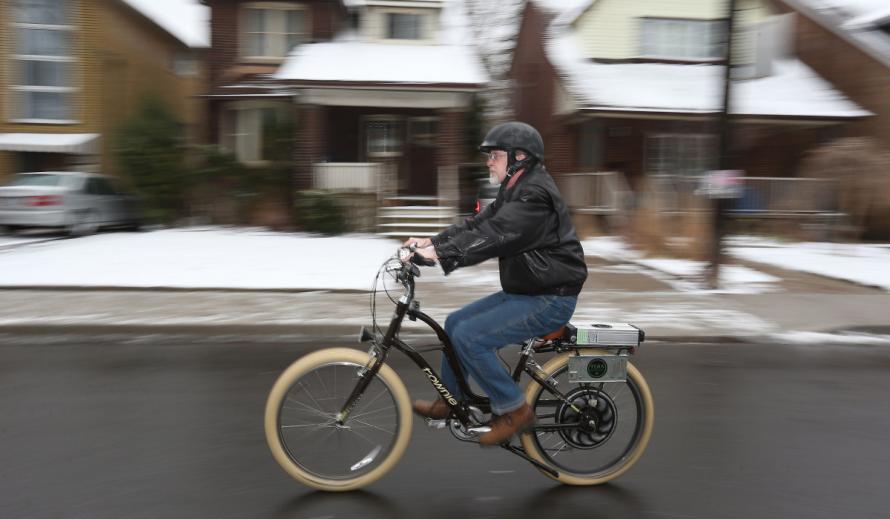Rain fell all day, but inside fresh baked goods greeted people at the Harbord Bakery for the Bagels for Bikes "buy-in" last Saturday. People arrived by bike hoping to persuade the Harbord Bakery to drop their opposition to the bidirectional bike lanes which would potentially remove about 20 parking spaces out of about 150 spaces on Harbord1. (Photo: Cycle Toronto)
Cycle Toronto members purchased bagels and other baked goods at the Harbord Bakery and chatted with the local merchants who had also provided some free pastries as a sort of olive branch to the wet cyclists who arrived to show their support for the City's separated bike lane plan.
It might bode well for the bike lanes that public works chair Denzil Minnan-Wong showed up to talk with cyclists and the merchants. Councillor Adam Vaughan, the councillor for that section of Harbord, was not there. It's unclear why.
The Harbord BIA's opposition may have wavered a little bit since the Star reported that the Bakery owner Susan Wisniewski figured the bidirectional bike lane was going to be a "horror story" that would lead to collisions. A bit of "father knows best" and the apocalypse rolled into one.
Neil Wright, Harbord BIA Chair, said that it was the BIA and not the Harbord Bakery which was pushing the anti-bike lane petition. It was unfair, he claimed, of the Toronto Star to put the Harbord Bakery as the leader in the fight against the Harbord bike lane. And even if the BIA was hosting the petition, Wright clarified that the Harbord BIA has yet to take an official stand on the proposed two-way cycle track. They will wait until the official proposal comes out in the next month or so. Is the BIA backtracking a bit or were they misquoted in the media?
We'll give you some love if you do the same
The Harbord BIA would do well to embrace cyclists as customers. Harbord is already the second busiest bike route in Toronto (after College), with cyclists representing 40 per cent of traffic during rush hour, according to a city report released in June. On any day, the Harbord Bakery and other businesses along the street likely see more dollars coming in from people who walked, biked or took TTC in then who drove. The evidence shows us that while drivers may spend more for each trip they make, cyclists return much more frequently and end up spending more.
With limited car parking and no more room for cars on the roadway, businesses need to look beyond cars for ways to attract customers. Green Apple Books in San Francisco realized this as well: "We're in a pretty congested neighborhood; parking is tough. There's no alleys, so delivery trucks have to do their business up front. On top of it, sidewalks are pretty narrow." Sounds like many downtown Toronto businesses.
Rather than killing business, the bidirectional bike lanes would make it easier for customers to arrive with a minimal loss of car parking (only 20 car parking spaces on all of Harbord). Between Queen's Park Circle and Ossington only 115 out of 195 (59%) of the parking spaces are occupied on average. Even after the loss of some spaces, the BIA will still have enough spaces nearby to meet all the peak demand. (The peak demand, by the way, is actually on weekday evenings which suggests that a lot of it is occupied by local residents and not even customers necessarily.)
Leave the predictions to the experts
Instead of predicting a coming apocalypse, businesses should be working with the City and with cyclists to better understand the risks of the various options and create a good plan with which we can all be happy. The best available evidence we have at this time suggest that bidirectional cycle tracks would be safer than the current door-zone cycling on Harbord. A study (Lusk et al.) of the bidirectional cycle tracks in Montreal and found them to be safer than the adjacent streets without any protection: “Compared with bicycling on a reference street…these cycle tracks had a 28% lower injury rate.”
No horror stories in Montreal: cycle tracks have made Montreal cyclists happier and safer. We can do the same here.
1. Yes, I'm talking again about Harbord Street. Not only is it a regular route for me (and many others), it is a bit of a bellweather of how political will in the face of merchant opposition for cycling infrastructure. If we can't bloody well finish the Harbord bike lane after a couple decades, then what hope do we have for Bloor or other downtown streets?


